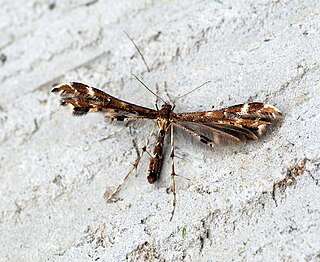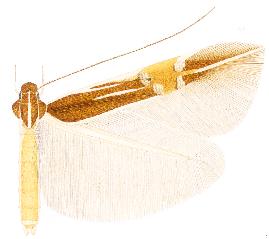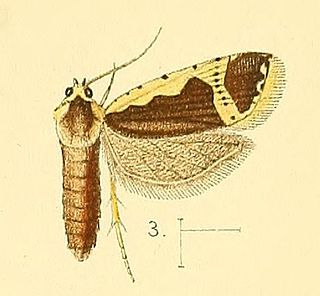
Appias lalage, the spot puffin, is a small butterfly of the family Pieridae, that is, the yellows and whites, which is found in India, Indochina and Hainan.
Xyroptila peltastes is a moth of the family Pterophoridae. It is found in Australia.

Hexadactilia trilobata is a moth of the family Pterophoridae described by Thomas Bainbrigge Fletcher in 1910. It is found in Australia in Queensland and New Guinea.

Deuterocopus atrapex is a moth of the family Pterophoridae described by Thomas Bainbrigge Fletcher in 1909. It has been recorded from Sri Lanka, Assam, Selangor, the Tenasserim Hills, south-eastern Borneo, Ternate, Ambon Island, Batian, southern Sulawesi, the Sangihe Islands, Halmahera, Neu Pommern, northern New Guinea, the Kei Islands, the D'Entrecasteaux Islands and Queensland.

Deuterocopus tengstroemi is a moth of the family Pterophoridae. It is known from Java and Queensland, Australia.

Sphenarches zanclistes is a moth of the family Pterophoridae that is found in Australia.

Capperia britanniodactylus, also known as the wood sage plume is a moth of the family Pterophoridae, found in Europe. It was first described by Charles Stuart Gregson in 1869.

Cosmopterix carpo is a moth of the family Cosmopterigidae. It is known from Puerto Rico and the British Virgin Islands (Tortola).

Cosmopterix damnosa is a moth of the family Cosmopterigidae. It is known from the United States.

Cosmopterix diaphora is a moth of the family Cosmopterigidae. It is known from the Federal District of Brazil and the states of Guerrero and Veracruz in Mexico.

Cosmopterix erinome is a moth of the family Cosmopterigidae. It is known from the United States.

Cosmopterix scirpicola is a moth of the family Cosmopterigidae. It is known from the United States, where found from Maryland and eastern Wyoming to Florida, south-western Louisiana and California. It has also been recorded from Alabama.

Pebobs kale is a moth of the family Cosmopterigidae. It is known from Peru and Trinidad and Tobago.

Panegyra flavicostana is a species of moth of the family Tortricidae. It is found in Cameroon, Nigeria and Gambia.
Depressaria togata is a moth in the family Depressariidae. It was described by Lord Walsingham in 1889. It is found in North America, where it has been recorded from Montana, from British Columbia to Arizona and in Oregon and Washington.
Exaeretia hildaella is a moth in the family Depressariidae. It was described by John Frederick Gates Clarke in 1941. It is found in North America, where it has been recorded from Alberta and the Northwest Territories.
Ardozyga odorifera is a species of moth in the family Gelechiidae. It was described by Edward Meyrick in 1904. It is found in Australia, where it has been recorded from New South Wales and Queensland.
Telphusa perspicua is a moth of the family Gelechiidae. It is found in the West Indies, where it has been recorded from Hispaniola, Cuba and Puerto Rico.
Filatima vaniae is a moth of the family Gelechiidae. It is found in North America, where it has been recorded from Utah and California.
Aeolanthes lychnidias is a moth in the family Depressariidae. It was described by Edward Meyrick in 1908. It is found in southern India.







